Abstract
Decreased ventilatory responses to hypoxia and hypercapnia have been demonstrated in a variety of disorders; however, the etiology of these decreased drives remains virtually unknown. Recent observations have suggested a familial influence on hypoxic and hypercapnic ventilatory response, but it is unclear whether this influence is the result of hereditary or environmental influences. Therefore we measured the ventilatory response to isocapnic hypoxia (HVR) and hyperoxic hypercapnia in 12 pairs of identical and 12 pairs of nonidentical twins. Significant correlation (P less than 0.01) was found for HVR within identical twin pairs but not within nonidentical twin pairs. Identical twins resembled each other more closely with respect to HVR than was the case for nonidentical twins (P less than 0.0125). This was independent of body size, blood PCO2, or pH. No such correlation could be found for ventilatory response to hyperoxic hypercapnia. It is concluded that hereditary influences affect HVR and it is speculated that such influences may play a role in clinical conditions characterized by decreased hypoxic ventilatory responses.
Full text
PDF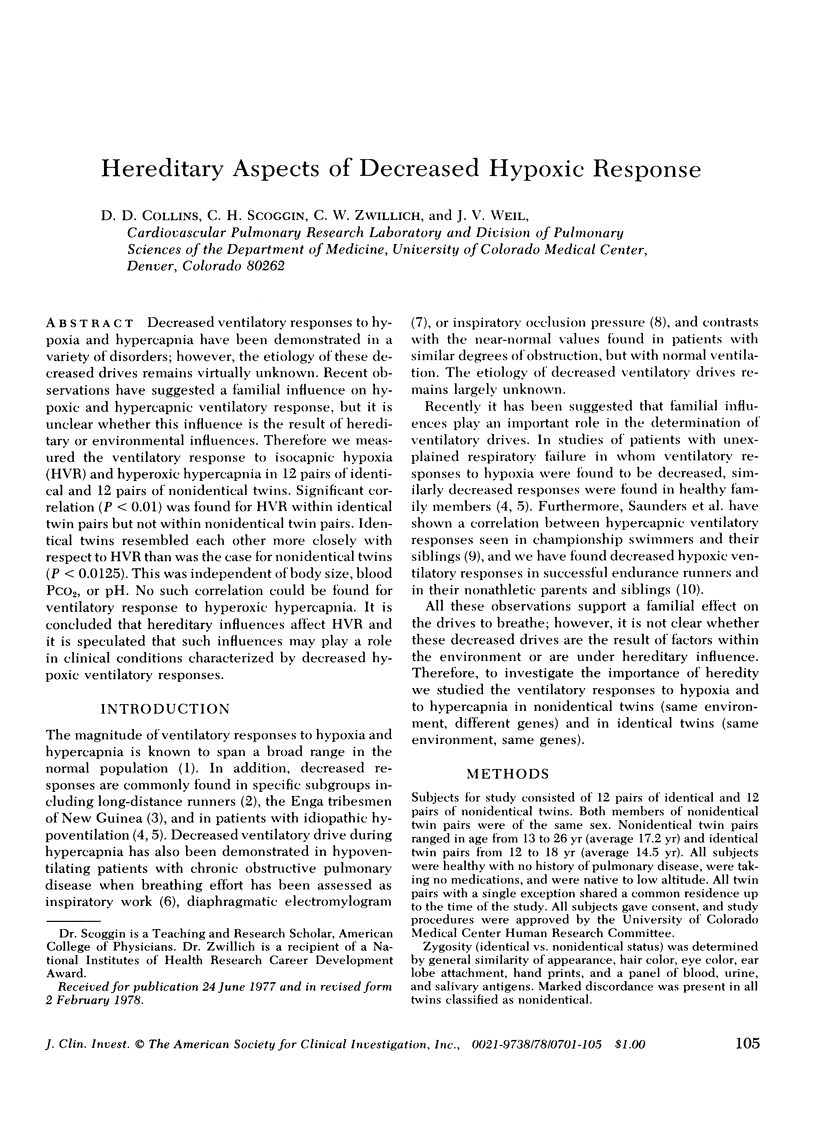
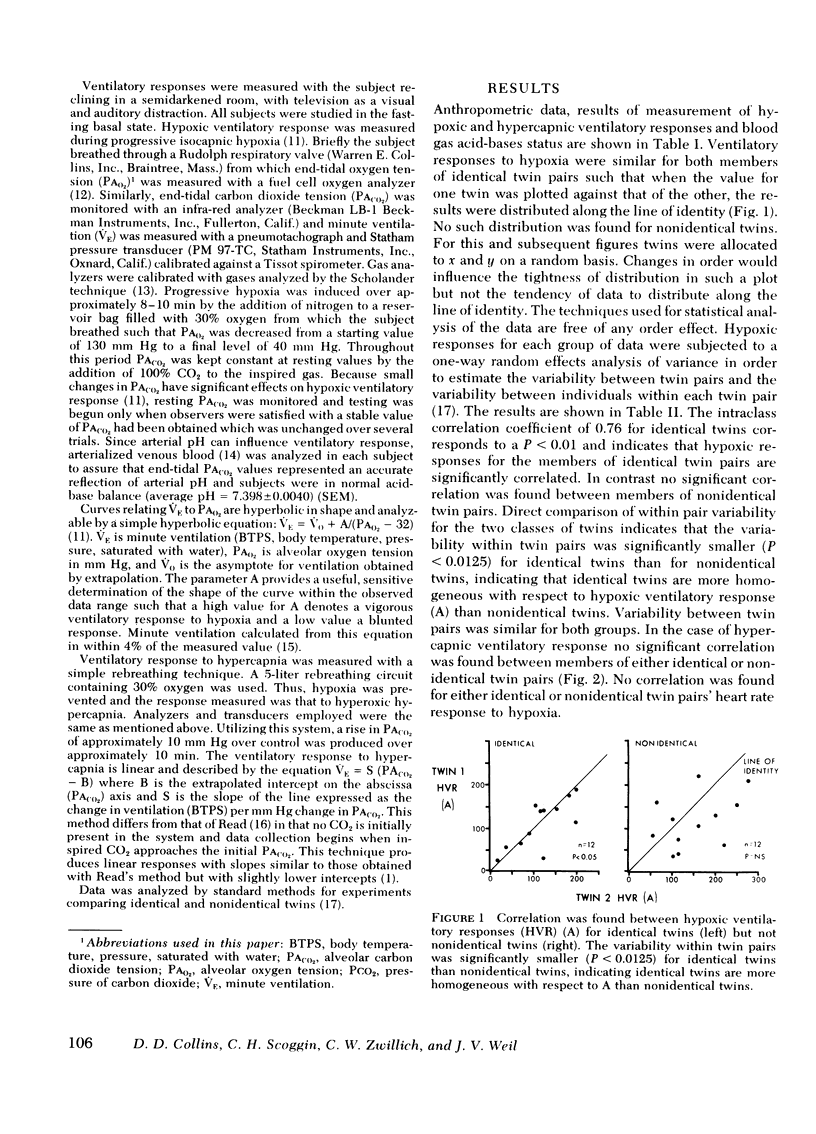
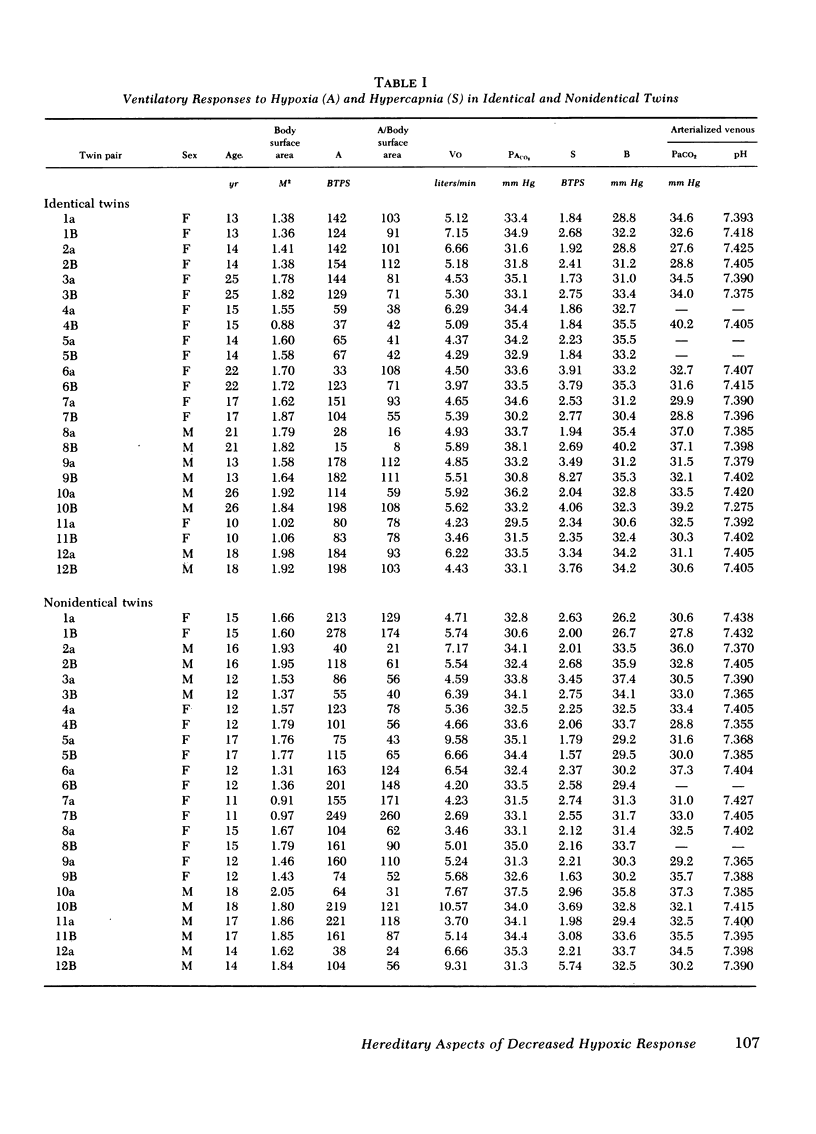
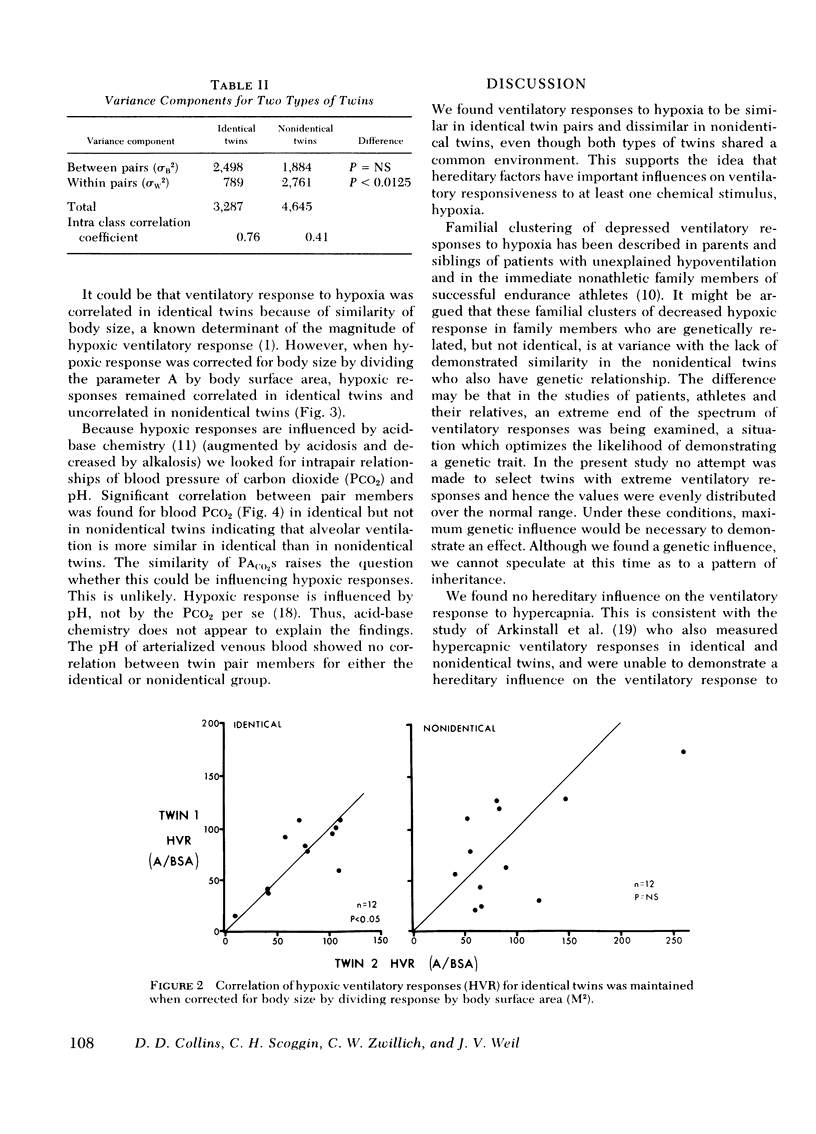
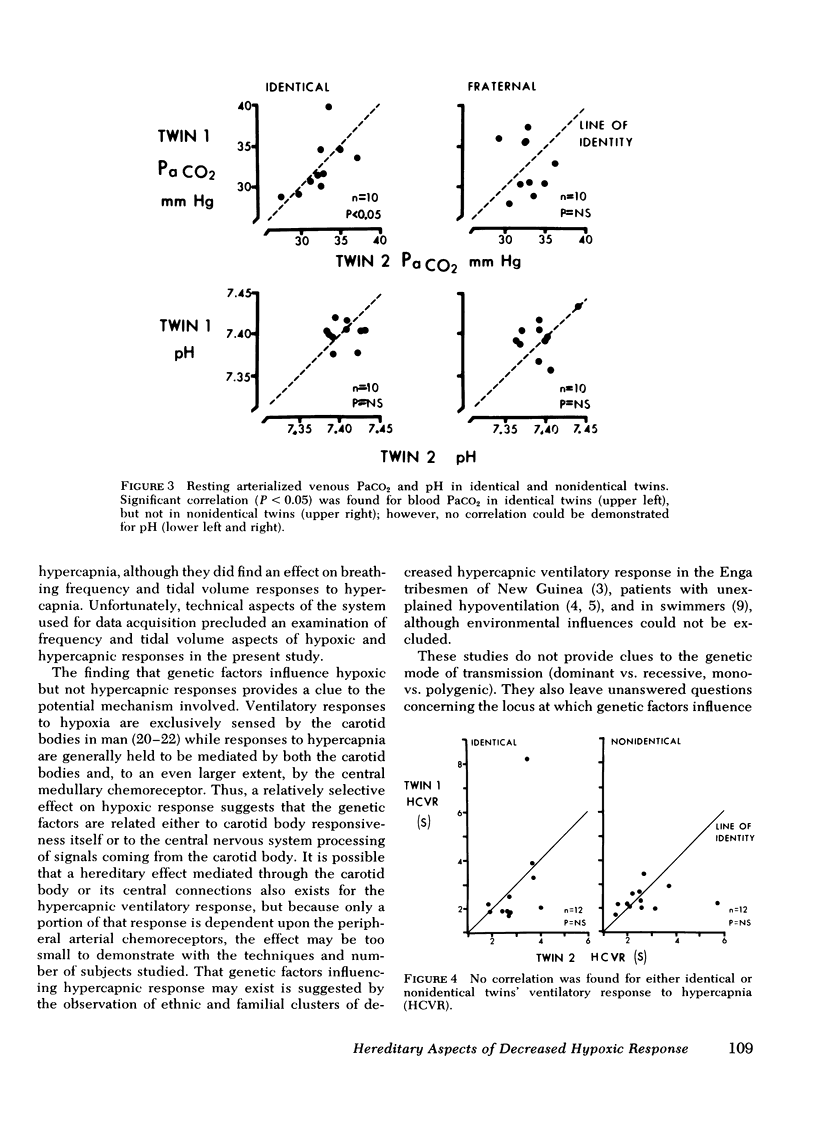
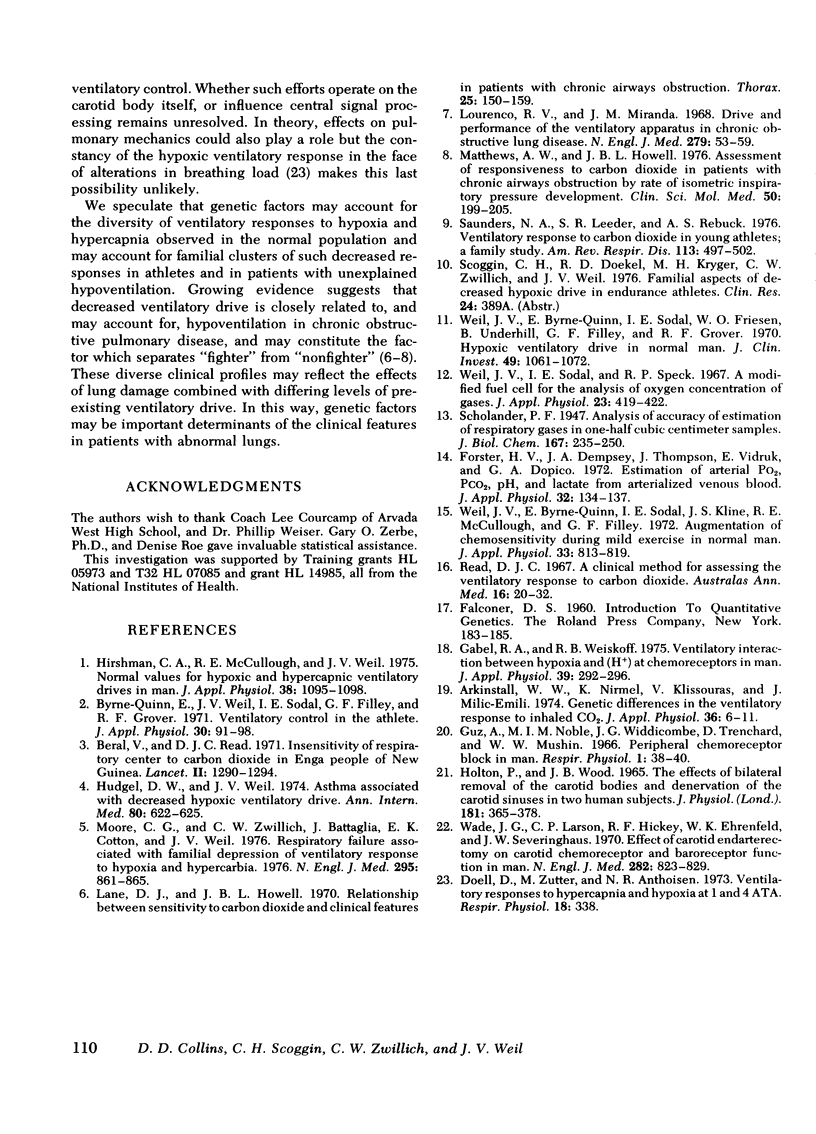
Selected References
These references are in PubMed. This may not be the complete list of references from this article.
- Arkinstall W. W., Nirmel K., Klissouras V., Milic-Emili J. Genetic differences in the ventilatory response to inhaled CO2. J Appl Physiol. 1974 Jan;36(1):6–11. doi: 10.1152/jappl.1974.36.1.6. [DOI] [PubMed] [Google Scholar]
- Beral V., Read D. J. Insensitivity of respiratory centre to carbon dioxide in the Enga people of New Guinea. Lancet. 1971 Dec 11;2(7737):1290–1294. doi: 10.1016/s0140-6736(71)90606-4. [DOI] [PubMed] [Google Scholar]
- Byrne-Quinn E., Weil J. V., Sodal I. E., Filley G. F., Grover R. F. Ventilatory control in the athlete. J Appl Physiol. 1971 Jan;30(1):91–98. doi: 10.1152/jappl.1971.30.1.91. [DOI] [PubMed] [Google Scholar]
- Doell D., Zutter M., Anthonisen N. R. Ventilatory responses to hypercapnia and hypoxia at 1 and 4 ATA. Respir Physiol. 1973 Sep;18(3):338–346. doi: 10.1016/0034-5687(73)90097-2. [DOI] [PubMed] [Google Scholar]
- Forster H. V., Dempsey J. A., Thomson J., Vidruk E., DoPico G. A. Estimation of arterial PO2, PCO2, pH, and lactate from arterialized venous blood. J Appl Physiol. 1972 Jan;32(1):134–137. doi: 10.1152/jappl.1972.32.1.134. [DOI] [PubMed] [Google Scholar]
- Gabel R. A., Weiskopf R. B. Ventilatory interaction between hypoxia and [H+] at chemoreceptors of man. J Appl Physiol. 1975 Aug;39(2):292–296. doi: 10.1152/jappl.1975.39.2.292. [DOI] [PubMed] [Google Scholar]
- Guz A., Noble M. I., Widdicombe J. G., Trenchard D., Mushin W. W. Peripheral chemoreceptor block in man. Respir Physiol. 1966;1(1):38–40. doi: 10.1016/0034-5687(66)90027-2. [DOI] [PubMed] [Google Scholar]
- Hirshman C. A., McCullough R. E., Weil J. V. Normal values for hypoxic and hypercapnic ventilaroty drives in man. J Appl Physiol. 1975 Jun;38(6):1095–1098. doi: 10.1152/jappl.1975.38.6.1095. [DOI] [PubMed] [Google Scholar]
- Holton P., Wood J. B. The effects of bilateral removal of the carotid bodies and denervation of the carotid sinuses in two human subjects. J Physiol. 1965 Nov;181(2):365–378. doi: 10.1113/jphysiol.1965.sp007767. [DOI] [PMC free article] [PubMed] [Google Scholar]
- Hudgel D. W., Weil J. V. Asthma associated with decreased hypoxic ventilatory drive. A family study. Ann Intern Med. 1974 May;80(5):623–625. doi: 10.7326/0003-4819-80-5-622. [DOI] [PubMed] [Google Scholar]
- Lane D. J., Howell J. B. Relationship between sensitivity to carbon dioxide and clinical features in patients with chronic airways obstruction. Thorax. 1970 Mar;25(2):150–159. doi: 10.1136/thx.25.2.150. [DOI] [PMC free article] [PubMed] [Google Scholar]
- Lourenço R. V., Miranda J. M. Drive and performance of the ventilatory apparatus in chronic obstructive lung disease. N Engl J Med. 1968 Jul 11;279(2):53–59. doi: 10.1056/NEJM196807112790201. [DOI] [PubMed] [Google Scholar]
- Matthews A. W., Howell J. B. Assessment of responsiveness to carbon dioxide in patients with chronic airways obstruction by rate of isometric inspiratory pressure development. Clin Sci Mol Med. 1976 Mar;50(3):199–205. doi: 10.1042/cs0500199. [DOI] [PubMed] [Google Scholar]
- Moore G. C., Zwillich C. W., Battaglia J. D., Cotton E. K., Weil J. V. Respiratory failure associated with familial depression of ventilatory response to hypoxia and hypercapnia. N Engl J Med. 1976 Oct 14;295(16):861–865. doi: 10.1056/NEJM197610142951604. [DOI] [PubMed] [Google Scholar]
- Read D. J. A clinical method for assessing the ventilatory response to carbon dioxide. Australas Ann Med. 1967 Feb;16(1):20–32. doi: 10.1111/imj.1967.16.1.20. [DOI] [PubMed] [Google Scholar]
- Saunders N. A., Leeder S. R., Rebuck A. S. Ventilatory response to carbon dioxide in young athletes: a family study. Am Rev Respir Dis. 1976 Apr;113(4):497–502. doi: 10.1164/arrd.1976.113.4.497. [DOI] [PubMed] [Google Scholar]
- Wade J. G., Larson C. P., Jr, Hickey R. F., Ehrenfeld W. K., Severinghaus J. W. Effect of carotid endarterectomy on carotid chemoreceptor and baroreceptor function in man. N Engl J Med. 1970 Apr 9;282(15):823–829. doi: 10.1056/NEJM197004092821501. [DOI] [PubMed] [Google Scholar]
- Weil J. V., Byrne-Quinn E., Sodal I. E., Friesen W. O., Underhill B., Filley G. F., Grover R. F. Hypoxic ventilatory drive in normal man. J Clin Invest. 1970 Jun;49(6):1061–1072. doi: 10.1172/JCI106322. [DOI] [PMC free article] [PubMed] [Google Scholar]
- Weil J. V., Byrne-Quinn E., Sodal I. E., Kline J. S., McCullough R. E., Filley G. F. Augmentation of chemosensitivity during mild exercise in normal man. J Appl Physiol. 1972 Dec;33(6):813–819. doi: 10.1152/jappl.1972.33.6.813. [DOI] [PubMed] [Google Scholar]
- Weil J. V., Sodal I. E., Speck R. P. A modified fuel cell for the analysis of oxygen concentration of gases. J Appl Physiol. 1967 Sep;23(3):419–422. doi: 10.1152/jappl.1967.23.3.419. [DOI] [PubMed] [Google Scholar]


